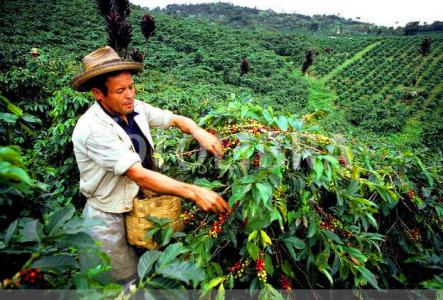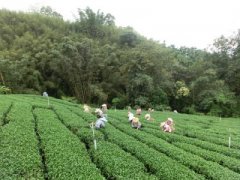A brief introduction to the cultivation of Yemeni boutique coffee beans with unique fragrance, geographical location, climate and altitude

Yemeni coffee is also picked and processed entirely by hand. The preliminary processing of coffee beans is made by drying and drying naturally in the sun. This method is the most primitive and simple, without any machinery or cleaning, so sometimes there are a small amount of sand and pebbles in Yemeni coffee beans. At present, only Brazil, Haiti and a few parts of India still use drying method to treat coffee beans. The coffee roasting process is also done entirely by hand, and the heat depends entirely on experience and feeling. Every process from planting, picking to roasting is done in the oldest way, and although the roasted beans are of different colors, it is this aroma mixed with rugged and wild flavors that makes the unique Yemeni mocha coffee. No wonder some people call Mocha "the diamond in the crown of Asian coffee".
Yemeni coffee has different names according to its specific origin, and there are 13 main kinds of coffee. Although the taste and flavor are slightly different, it is still collectively called mocha. Among them, the most famous varieties, such as Sanani, Mattari and Harazi, are mainly distributed in the mountains around the capital Sana'an and the high-altitude mountains between Sana'an and Hodeida province. Yemeni mocha coffee has small fruit, high density, high acidity and unique aroma, which is more sour than other famous coffee varieties, as well as a mixture of malt, nuts, wine, chocolate and other spices, smooth taste and fragrant smell.
The Yemeni mocha coffee has distinct taste characteristics, special taste and varied levels. It has a strong sour taste, a pleasant fruit acidity, and an obvious chocolate taste. The stronger the coffee is, the easier it is to taste the chocolate. Therefore, in order to better understand the unique taste of Yemeni mocha coffee, people now add hot chocolate to make fancy mocha coffee.
Mocha beans are smaller, rounder and light green than most coffee beans, which makes mocha beans look more like peas. Mocha coffee beans are similar in shape to Ethiopia's Harald coffee beans, with small particles, high acidity and a strange and indescribable spicy flavor.
The price of Yemeni coffee in the international market has not been low, mainly because Yemeni coffee is very popular in countries and regions where "Turkish" coffee is popular. In Saudi Arabia, the Yemeni mocha is so spoiled that people there are willing to pay a high price for low-quality mocha coffee. This special love of mocha has kept the price of mocha coffee high in the world coffee market although Ethiopia was the first country in the world to find coffee, however, Yemen was the first country in the world to produce coffee as a crop on a large scale. In the 17th century, the first Yemeni coffee was exported to Europe through the ancient small port of Mocha, which is the origin of the name Mocha coffee. Ethiopia, across the sea from Yemen, also sells coffee through the port of Mocha, so Ethiopian sun-treated coffee is often referred to as mocha (such as Harald ETHIOPIA HARRAR, Ethiopia). The Yemeni mocha is the originator of the coffee trade of the World Office, and has played an important role in promoting delicious coffee all over the world. It was called "Arabia" in the 17th century, which is the origin of the name "Arabica". This is the oldest coffee in the world-- Yemeni mocha coffee.
Origin: Yemen
Grade: excellent
Particles: full
Acidity: slightly sour and strong aftereffect, but also sweet
Evenness: relatively stable
Baking: medium
Flavor: chocolate, slightly alcoholic, spicy
Yemenis have had the habit of drinking coffee since ancient times, and the coffee culture here is very different from that of other parts of the world. In Yemen, there are many middlemen engaged in the acquisition and storage of coffee, the newly purchased coffee is in no hurry to sell every year, and coffee farmers also hoard coffee at home as a means of saving. the ones that really enter the market are often old beans that have been in stock for several years. Due to the dry climate and lack of rain in Yemen, the water content of these coffee beans is very low, which gives Yemeni coffee a very unique taste.
In the coastal plain of the Red Sea in western Yemen, the climate and soil and water conditions are not suitable for growing coffee, and coffee is mainly produced in the western mountains. Mocha coffee grows in the mountains at an altitude of 3000 meters, where the geographical environment is unique, the mountain is rugged, the air is thin, the light is strong, and the water comes from rainfall and mountain springs, which make mocha coffee special aroma and taste. The local farmers carved out fertile terraces on the hillside. To this day, coffee is still grown in the same way in these areas as it was three or four hundred years ago, relying entirely on artificial labor, never using any chemical fertilizers or pesticides, and relying on sunshine, Rain Water and unique soil to grow pure natural Yemeni coffee. In fact, coffee grown in Haiti, Ethiopia and the West Indies belongs to the same ancestry as Yemeni coffee, and many of them are known as mocha coffee. However, for a variety of reasons, their taste and aroma are very different from those of mocha coffee produced in Yemen.
Important Notice :
前街咖啡 FrontStreet Coffee has moved to new addredd:
FrontStreet Coffee Address: 315,Donghua East Road,GuangZhou
Tel:020 38364473
- Prev

A brief introduction to the market price of spicy and exciting Yemeni boutique coffee beans
The price of Yemeni coffee in the international market has not been low, mainly because Yemeni coffee is very popular in countries and regions where Turkish coffee is popular. In Saudi Arabia, the Yemeni mocha is so spoiled that people there are willing to pay a high price for low-quality mocha coffee. This special fondness for mocha makes mocha coffee priced in the world coffee market.
- Next

A brief introduction to the treatment method of grinding degree and baking degree of Yemeni boutique coffee beans with endless aftertaste
There are many varieties of Yemeni coffee, most of which are named after their origin and type, with different flavors, such as fresh wood, tobacco, musk, fruit wine, roasted nuts, cocoa and warm seasonings, especially Moha coffee. At present, Yemeni Moha coffee is most famous on the market, such as Isemary, Matari, Sanani and other varieties. Sanani coffee has medium-sized beans and fruit wine style.
Related
- Detailed explanation of Jadeite planting Land in Panamanian Jadeite Manor introduction to the grading system of Jadeite competitive bidding, Red bid, Green bid and Rose Summer
- Story of Coffee planting in Brenka region of Costa Rica Stonehenge Manor anaerobic heavy honey treatment of flavor mouth
- What's on the barrel of Blue Mountain Coffee beans?
- Can American coffee also pull flowers? How to use hot American style to pull out a good-looking pattern?
- Can you make a cold extract with coffee beans? What is the right proportion for cold-extracted coffee formula?
- Indonesian PWN Gold Mandrine Coffee Origin Features Flavor How to Chong? Mandolin coffee is American.
- A brief introduction to the flavor characteristics of Brazilian yellow bourbon coffee beans
- What is the effect of different water quality on the flavor of cold-extracted coffee? What kind of water is best for brewing coffee?
- Why do you think of Rose Summer whenever you mention Panamanian coffee?
- Introduction to the characteristics of authentic blue mountain coffee bean producing areas? What is the CIB Coffee Authority in Jamaica?

